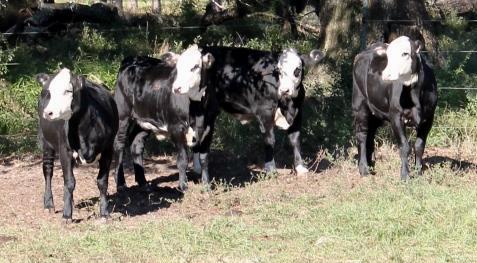
A defined breeding/calving season results in a more uniformed calf crop and more management options for both large and small herds. Photo Credit: Mark Mauldin
There is a mountain of good research data out there that shows that one of the best cattle herd management strategies is a defined breeding season. The breeding season should be less than 120 days, and ideally should be 60 – 90 days to see all the associated management benefits. If you are unclear regarding the benefits of a defined breeding season, see the links at the bottom of the page or give your County Agricultural Agent a call. If you have heard all the reasons why you should implement a defined breeding season, but still have no plans to do so, then please consider the following recommendations.
When you leave the bull in with the cows year-round, you have created a situation that is perfect for hiding under-performing cows. The hallmark of a defined breeding season is to set an annual deadline when cows are kept or culled based on pregnancy status. Without the deadline it is easy for cows to fly “under the radar” with ever increasing calving intervals. Under-performing cows – cows that fail to wean a calf EVERY YEAR are financial liabilities.
Regardless of your management system or level of inputs, cattle that generate negative returns won’t work. The situation compounds over time. The longer you keep under-performing cows around the more financial damage they do. The long-term financial viability of your cattle enterprise can depend heavily on your ability to identify and remove under-performing cows.
Think about it like this – the average carrying cost per cow is $600/yr. (if this sounds high, sit down and put a pencil to it) with 550 lbs. of calf weaned each year. In this scenario, the calf needs to sell for $1.09/lbs. in order for the cow to “pay her bill” for the year. With this same scenario, weaning a calf every 18 or 24 months the breakeven price goes up to $1.63/lbs. and $2.18/lbs. respectively. With current calf prices in the neighborhood of $1.50/lbs. and expected to decline, you can see how cows that calve less than once a year just won’t work.
If you are going to have a year-round breeding season, what can you do to identify cows that aren’t keeping up their end of the bargain?
- Individually ID all of your brood cows. You need to know exactly which cow you are looking at.
- Record calving dates. Writing tag numbers on a paper calendar is a simple way to start.
- Cull cows that don’t calve within one year. One year from the previous calving date have her pregnancy checked. You may market her differently if she is bred, but she should be culled either way.
Most folks will be fine with the first two points; it’s the culling that people don’t like. Not culling is a bad decision, but these are your cows, and your call. If you follow just the first two steps for a few years, what you will likely begin to see is that those cows you thought you would help by giving them “another month or two” will continue to increase their calving interval as time goes on. At best, they will hold steady. It is highly unlikely that the interval will shorten, unless an outside factor, like inadequate nutrition that is causing the problem is addressed.
If a substantial portion of your herd is not giving you a calf every 365 days, you need to evaluate your management system, and find the limiting factor. Look at nutrition, age of cows, and breeding soundness of the bull first. Biologically, during her productive life, a cow is perfectly able to have a calf every year. Regardless of management practices, there will always be individual cows that won’t perform well in your operation. These are the ones that you can’t afford to allow to hide in your year-round breeding system.
Defining a breeding season is the best option, but if that’s not going to happen, implement a system that enables you to track each cow’s calving interval. Identifying and culling under-performing cows will prevent continued investment in cows that aren’t generating positive returns.
For more discussion on this topic and other aspects of herd reproductive management, attend Beef Cattle Basics Session 2 on Tuesday May 8.
To read more about this topic, use the following links:
Converting the Beef Cow Herd to a Controlled Breeding Season
Controlled Breeding and Calving Season
How to Improve Your Percent Calf Crop
Calving Season Selection Considerations
The Benefits of Halving a Controlled Calving Season
The Cost of Late Calving Cows
- Peanut Maturity Update – 10/9/25 - October 10, 2025
- Fall Can be a Great Time for Vegetation Management - October 3, 2025
- Peanut Maturity Update – 9/25/25 Edition - September 26, 2025
